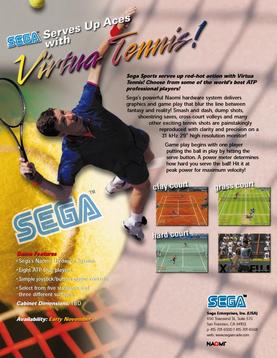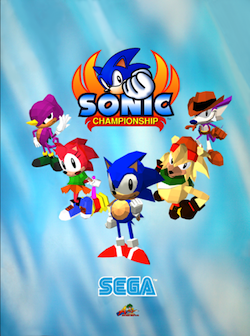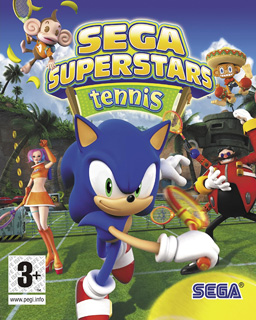
Virtua Tennis, known in Japan as Power Smash, is a 1999 tennis arcade game created by Sega. The player competes through tennis tournaments in an arcade mode. It was ported to the Dreamcast in 2000, and to Windows in 2002. A Game Boy Advance version was also released in 2002, followed by an N-Gage version in 2003. For the home console market, the game was expanded with the introduction of the campaign mode.

Yu Suzuki is a Japanese game designer, producer, programmer, and engineer, who headed Sega's AM2 team for 18 years. Considered one of the first auteurs of video games, he has been responsible for a number of Sega's arcade hits, including three-dimensional sprite-scaling games that used "taikan" motion simulator arcade cabinets, such as Hang-On, Space Harrier, Out Run and After Burner, and pioneering polygonal 3D games such as Virtua Racing and Virtua Fighter, which are some of the games besides others from rival companies during that era credited with popularizing 3D graphics in video games; as well as the critically acclaimed Shenmue series. As a hardware engineer, he led the development of various arcade system boards, including the Sega Space Harrier, Model 1, Model 2 and Model 3, and was involved in the technical development of the Dreamcast console and its corresponding NAOMI arcade hardware.

Sonic the Fighters, also known as Sonic Championship, is a 1996 three-dimensional fighting video game from Sega. The game, developed by Sega AM2 and built on their Model 2 arcade system, pits players in one-on-one battles with a roster of characters from the Sonic the Hedgehog series. Sonic the Fighters was made using the fighting engine for Fighting Vipers (1995), and it was the first 3D game in the Sonic series; the idea for a Sonic fighting game was conceived when a Sega AM2 programmer experimented with a 3D Sonic the Hedgehog model in Fighting Vipers, its animation impressing and convincing the Sonic Team to approve the project.
In the history of video games, the sixth generation era is the era of computer and video games, video game consoles, and handheld gaming devices available at the turn of the 21st century, starting on November 27, 1998. Platforms in the sixth generation include consoles from four companies: the Sega Dreamcast (DC), Sony PlayStation 2 (PS2), Nintendo GameCube (GC), and Microsoft Xbox. This era began on November 27, 1998, with the Japanese release of the Dreamcast, which was joined by the PlayStation 2 on March 4, 2000, the GameCube on September 14, 2001 and the Xbox on November 15, 2001, respectively. On March 31, 2001, the Dreamcast was among the first to be discontinued. Xbox in 2006, GameCube in 2007 and PlayStation 2 was the last, in January 2013. Meanwhile, the seventh generation of consoles started on November 22, 2005, with the launch of the Xbox 360.

Altered Beast is a 1988 beat 'em up arcade video game developed and published by Sega. The game is set in Ancient Greece and follows a player character chosen by Zeus to rescue his daughter Athena from the demonic ruler of the underworld, Neff. By collecting three power-ups in a level, the player character transforms into one of five magical beasts. It was ported to several home video game consoles and home computers. Altered Beast was the pack-in game when the Genesis launched in North America and the Mega Drive in Europe.

Daytona USA is a 1994 arcade racing game developed by Japanese studio Sega AM2. Inspired by the popularity of the NASCAR motor racing series in the US, the game has players race stock cars on one of three courses. It was the first game to be released on the Sega Model 2 arcade system board. Released by Sega in March of 1994, Daytona USA is one of the highest-grossing arcade games of all time.

Virtua Tennis 2, known as Tennis 2K2 in North America and Power Smash 2 in Japan, is a sequel to Virtua Tennis that was released for the Sega Dreamcast, Sega NAOMI arcade unit and Sony's PlayStation 2 in 2001–2002. New features included the ability to slice and play as female players such as Monica Seles, Serena Williams, Venus Williams and Lindsay Davenport and the males such as Patrick Rafter, Magnus Norman, Thomas Enqvist and Carlos Moyá and mixed doubles matches. The game was created and produced by Hitmaker, with Acclaim Entertainment publishing it in Europe for the PS2. This was the last Virtua Tennis game to be released for the Dreamcast following its discontinuation.

Crazy Taxi is a series of racing games developed by Hitmaker and published by Sega. It was first available as an arcade video game in 1999, then released for the Dreamcast console in 2000. It is the third best-selling Dreamcast game in the United States, selling over a million copies. The game was later ported to the PlayStation 2, GameCube, and IBM PC compatibles with sequels also appearing on the Xbox, Game Boy Advance, and PlayStation Portable systems.

Virtua Striker is a series of association football sports video games released by Sega for arcades. Originally developed by Sega AM2 from 1994 to 1999, the series moved to Amusement Vision with Virtua Striker 3, but it later moved to Sega Sports Design R&D Dept. with Virtua Striker 4.

Virtua Fighter 2 is a 1994 fighting video game by Sega. It is the sequel to Virtua Fighter (1993), and the second game in the Virtua Fighter series. Created by Sega's Yu Suzuki-headed AM2 team, it was designed on the purpose-made Sega Model 2 hardware which provided a significant upgrade in graphical capabilities. Following its release on the arcades, Virtua Fighter 2 was ported to the Sega Saturn home console in November 1995, while ports for some other platforms appeared later.

G.rev Ltd., short for G.revolution, is a Japanese video game developer. The company was founded by former employees of Taito's arcade division who had worked on G-Darius and RayStorm, and is known primarily for their arcade shoot 'em up games.

Virtua Fighter 5 is a fighting video game developed and published by Sega. It is the fifth installment of the Virtua Fighter series. The original version was released in July 2006 on the Sega Lindbergh arcade system board with a number of updates before home ports were released for PlayStation 3 and Xbox 360 in 2007. The first major update was Virtua Fighter 5 R (2008), followed by Virtua Fighter 5 Final Showdown (2010), with the latter ported to home systems in 2012. A remastered version of Final Showdown was released in 2021 as Virtua Fighter 5 Ultimate Showdown on PlayStation 4 and Japanese arcades, with a Windows port, Virtua Fighter 5 R.E.V.O., scheduled for a 2024 release.

Dead or Alive is a 1996 fighting game developed and published by Tecmo for arcades. It is the first entry in the Dead or Alive series. Built on the Sega Model 2 hardware, it was released first in arcades in 1996, followed by home ports for the Sega Saturn in Japan during 1997, and for the PlayStation in all regions during 1998.
Virtua Fighter is a series of fighting games created by Sega AM2 and designer Yu Suzuki. The original Virtua Fighter was released in December 1993 and has received four main sequels and several spin-offs. The highly influential first Virtua Fighter game is widely recognized as the first 3D fighting game released. The latest mainline release was Virtua Fighter 5 in 2006; this version has since been continuously updated.

Virtua Tennis 3, known in Japan as Sega Professional Tennis: Power Smash 3, is the second arcade game sequel to Sega's tennis game franchise, Virtua Tennis. The arcade version of Virtua Tennis 3 is powered by the PC-based Sega Lindbergh arcade system board. Ports for the PC, Xbox 360, PlayStation Portable and PlayStation 3 consoles are also available with a traditional collection of tennis minigames that the home versions of Virtua Tennis are known for. In 2009, Sega updated and re-created Virtua Tennis 3 in Virtua Tennis 2009.

Sega Superstars Tennis is a sports video game developed by Sumo Digital and published by Sega. It is the second title in the Sega All-Stars series, preceded by Sega Superstars (2004), and crosses over characters, locations, and soundtracks from several Sega franchises, including Sonic the Hedgehog, Space Channel 5, and Super Monkey Ball.

Virtua Tennis 2009, known in Japan as Power Smash: Live Match!, is a 2009 video game developed by Sumo Digital and published by Sega. It is part of the Virtua Tennis series, following Virtua Tennis 3.

Sonic & Sega All-Stars Racing is a 2010 kart racing video game developed by Sumo Digital and published by Sega. It was released for Wii, Xbox 360, PlayStation 3, Nintendo DS, and Windows, featuring characters from multiple Sega franchises. The game is the third title in the Sega All-Stars series, preceded by Sega Superstars Tennis. A mobile version was developed by Gameloft, and released for iOS in June 2011, as a paid download. A version for OS X was released by Feral Interactive in April 2013.

Virtua Tennis 4, known in Japan as Power Smash 4, is the third sequel to Sega's tennis game franchise, Virtua Tennis. It was released on PlayStation 3, Xbox 360, Microsoft Windows, Wii and PlayStation Vita. This is the first main series Virtua Tennis game to not have an arcade release before the console releases. An arcade version was also released, which is powered by the PC-based Sega RingEdge arcade system. There are two versions of the cabinet: an upright 4-player cabinet, and a deluxe 4-player cabinet.
In the video game industry, a console war describes the competition between two or more video game console manufacturers in trying to achieve better consumer sales through more advanced console technology, an improved selection of video games, and general marketing around their consoles. While console manufacturers are generally always trying to out-perform other manufacturers in sales, these console wars engage in more direct tactics to compare their offerings directly against their competitors or to disparage the competition in contrast to their own, and thus the marketing efforts have tended to escalate in back-and-forth pushes.

















